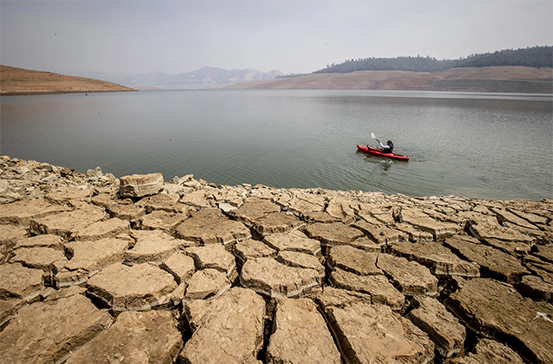Keep Conserving Water, California

It’s tempting to think that the “atmospheric rivers” that have deluged California and neighboring states with more than 32 million gallons of rain and snow mean that the drought is finally over. Many reservoirs are at close-to-normal levels for the first time in years, and some areas have actually experienced dangerous flooding. But Californians need to remain vigilant about water consumption and saving water. Why?
Simple physics has a lot to do with it. Yes, reservoirs are being replenished by rainfall and the higher volume in rivers that feed into them. But when that much water hits hard ground after so many years of drought-level precipitation, a lot of the water simply runs off and ends up back in the ocean. The baked ground can’t absorb it as fast as it falls, causing problems with excessive runoff and flash flooding. In turn, that runoff erodes the vital topsoil that holds onto water AND the vegetation that holds the topsoil in place. Extremes in weather are rarely good, long-term. The state is actually releasing water from reservoirs to help soak up incoming rain!
Aging infrastructure and water management plans that were designed before extreme weather became more common in the American West simply aren’t prepared to handle the changes of so much rain and snow. Efforts are being made to boost California’s water storage capacity, but it’s too late for much of that rain that’s already back in the Pacific Ocean. And water management experts are concerned that the area is going to see more weather whiplash between extreme wet and dry seasons, potentially further stressing that infrastructure.
So despite record precipitation, we need more water conservation to help the West meet challenges created by those decades of drought. By making conservation a way of life in California, we can save water, minimize water waste, rebuild our underground aquifers, prepare for the uncertainties of extreme weather cycles, and minimize the harmful effects of drought.
Of course, the drought is part of the driving force behind the record high water costs in California. We don’t expect that trend to change any time soon! For independent rental owners who own units with master-billed water and hot water, encouraging residents to conserve that valuable water is important to the health of their investments.
A popular solution for reducing the costs of master-billed utilities is submetering, which is exactly what it sounds like. Meters are installed in each unit to keep track of usage. Although it’s a solution which is accurate and transparent, it’s also a costly investment. Submetering requires the installation of expensive equipment and may not work in every unit space. Some units can’t be retrofitted or remodeled for the equipment. If submetering can’t work for your properties, Ratio Utility Billing may be the answer you’re looking for.
Ratio Utility Billing Systems, or RUBS, help housing providers drive conservation through accountability. RUBS fairly and transparently allocates water use among residents based on square footage, unit amenities, number of occupants and other factors. Housing providers can bill the residents each month and recover a significant portion of the money they spend on master-billed water.
Even if local ordinances prevent independent rental owners from charging residents for their water use, knowledge is power when it comes to getting residents to conserve so landlords can save. Studies show that simply informing Residents of their levels of consumption inspires them to conserve, saving thousands of dollars – and gallons – over time. You may see up to 40% reduced consumption if you’re able to bill Residents for use.
Educating tenants about better habits and easy changes that save water helps too. For example, most people aren’t aware that, if a family of four all let the water run while brushing their teeth twice a day, they waste 12,000 gallons of water over a year!
Livable is dedicated to conserving water and other natural resources while helping independent rental owners get more from their investments. To learn more about Livable’s innovative cost recovery solutions and educational initiatives for residents, visit livable.com.




